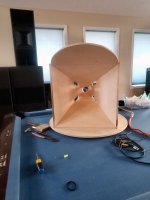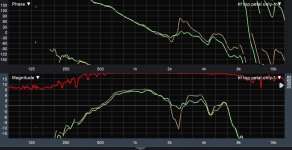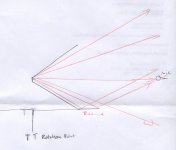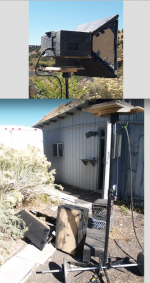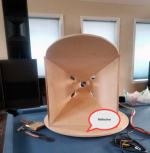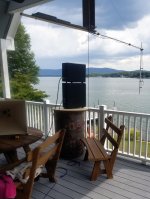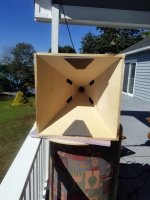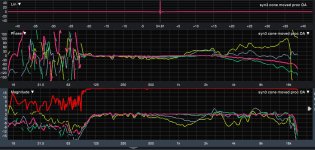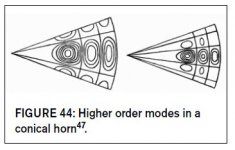Maybe I'm seeing your graphs wrong.. Is that the response from the mids or the HF driver? 600Hz to 8kHz doesn't seem like tweeter. That 2ish kHz dip looks a lot like a midrange reflection notch (quarterwave between mid apertures and the tweeter diaphragm). The reflection notch in a Synergy horn determines the upper limit of how high the midranges could play there, the reason why a lot of people try to get the mid apertures as close as possible to the tweeter throat.
Last edited:
Sorry for any confusion... The project has been about mating a bms 4594HE with a pair of 12"s.
When referring to the bms coax CD, I've called the lower section 'HF' (up to 6300Hz), and the high section 'VHF' (>6300Hz). When referring to the dcx464, folks have been calling the lower section of the dcx464 'mid' (up to 3200Hz), and the higher section 'HF' (>3200Hz).
I've been flip-flopping terminology, my bad.
Anyway, maybe the following might help clarify.. The pict is the 60x60 deg with one "petal" as previously described, attached to the horn. (albeit drivers removed) The transfer function graph green trace is that of one petal, as shown in the pict. The brown trace with the deep notch at 2.4kHz, is with the same sized petals attached to both sides of the horn in addition, so three petals total.
I can't see how the notch has anything to do with 1/4 wave reflections. It seems to be completely about mouth termination. I surely need help understanding !!!!
When referring to the bms coax CD, I've called the lower section 'HF' (up to 6300Hz), and the high section 'VHF' (>6300Hz). When referring to the dcx464, folks have been calling the lower section of the dcx464 'mid' (up to 3200Hz), and the higher section 'HF' (>3200Hz).
I've been flip-flopping terminology, my bad.
Anyway, maybe the following might help clarify.. The pict is the 60x60 deg with one "petal" as previously described, attached to the horn. (albeit drivers removed) The transfer function graph green trace is that of one petal, as shown in the pict. The brown trace with the deep notch at 2.4kHz, is with the same sized petals attached to both sides of the horn in addition, so three petals total.
I can't see how the notch has anything to do with 1/4 wave reflections. It seems to be completely about mouth termination. I surely need help understanding !!!!
Attachments
Yep, I even tried / measured the 60x60 before putting the woofer/midrange ports in, to see what changes the ports would make. Not much change really...maybe the ports amplified the pattern anomalies a little, but not enough to make me think the ports are a problem.
Biggest problem continues to appear to be either internal reflections in the straight sided conical horn, or mouth termination.....
Biggest problem continues to appear to be either internal reflections in the straight sided conical horn, or mouth termination.....
Mark,Biggest problem continues to appear to be either internal reflections in the straight sided conical horn, or mouth termination.....
From the picture, can't tell the angle of the "petal" to the horn side wall. If the "petals" are at the same angle as the horn wall, they shouldn't affect the horn performance much at all other than controlling dispersion to a lower frequency.
However, the portion of the turntable (and pool table) on the bottom of the horn is reflecting off axis response back across the center of the horn, definitely a bad thing as far as response linearity is concerned.
Unfortunately, the turntable must be rather small to avoid interfering with measurements, requiring a lot of rear weight to counterbalance the horn- below is an example of what happens when a gust of wind came up while checking out the prototype for the secondary expansion on the SynTripP. Later tests used a lot of bar clamps...
Art
Attachments
Ouch, damn wind ! Bummer...
The 'petals' had the same angle as the 60x60 horn. So it's really just a 60x60 with 3 sides having the rounded mouth. That's why I don't understand the deep 2.4kHz notch.
The pict on the pool table was just to show a petal. I'd never measure like that. The attached pict shows where/how I've been measuring, both for this thread and the dcx464 thread. The modular 12"/ dcx464/xt1464 rig is on the turntable, with the CD's acoustic center on top of turntable center. When I put either of the synergy protos on the table, with the CD's center over turntable center, the mouths extend over the fence rail. Fortunately the synergies are heavily rear weighted enough to allow this.
The 'petals' had the same angle as the 60x60 horn. So it's really just a 60x60 with 3 sides having the rounded mouth. That's why I don't understand the deep 2.4kHz notch.
The pict on the pool table was just to show a petal. I'd never measure like that. The attached pict shows where/how I've been measuring, both for this thread and the dcx464 thread. The modular 12"/ dcx464/xt1464 rig is on the turntable, with the CD's acoustic center on top of turntable center. When I put either of the synergy protos on the table, with the CD's center over turntable center, the mouths extend over the fence rail. Fortunately the synergies are heavily rear weighted enough to allow this.
Attachments
Oh well, nevermindThe pict on the pool table was just to show a petal. I'd never measure like that.
The attached pict shows where/how I've been measuring, both for this thread and the dcx464 thread.
Nice set up!
Ok, a bit of a breakthrough in making sense of measurements.
On the 60x60, using a dcx464 CD, I finally started noticing loopback timing descrepancies between the two CD sections.
On a xt1464, the lower dcx section (I'll call HF) lags the higher section (VHF) by about .08ms on-axis. And this lag stays the same going off axis. This is the same for the bms 4594he btw.
On the 60x60 synergy, the HF section lags the VHF by .40ms on-axis !!
This can't be !!
It appears to be caused by 4 summed reflections off the horn walls overpowering direct from throat signal.
Putting a small pad of acoustic foam in the center of any two horn panels changes the delay back to .08ms. By center I mean running from throat to mouth. Pad only has to be about 1.5" wide and about 4" long, at the mouth. Trapezoid doesn't work any better, but looks better. More than two sides messes up off-axis a little more than just two.
Part, but not all, of the on-axis vs off axis pattern oscillation I've been having trouble with, appears to be due to stitching together measurement based on the reflecting timing.
I've gone to rephase where every adjustment is manual to help sort things out. Polars are slowly improving And so is the sound
And so is the sound 
On the 60x60, using a dcx464 CD, I finally started noticing loopback timing descrepancies between the two CD sections.
On a xt1464, the lower dcx section (I'll call HF) lags the higher section (VHF) by about .08ms on-axis. And this lag stays the same going off axis. This is the same for the bms 4594he btw.
On the 60x60 synergy, the HF section lags the VHF by .40ms on-axis !!
This can't be !!
It appears to be caused by 4 summed reflections off the horn walls overpowering direct from throat signal.
Putting a small pad of acoustic foam in the center of any two horn panels changes the delay back to .08ms. By center I mean running from throat to mouth. Pad only has to be about 1.5" wide and about 4" long, at the mouth. Trapezoid doesn't work any better, but looks better. More than two sides messes up off-axis a little more than just two.
Part, but not all, of the on-axis vs off axis pattern oscillation I've been having trouble with, appears to be due to stitching together measurement based on the reflecting timing.
I've gone to rephase where every adjustment is manual to help sort things out. Polars are slowly improving
Attachments
That is a really nice location!! Not only for measuring loudspeakers!The attached pict shows where/how I've been measuring, both for this thread and the dcx464 thread.
That is something to make note of! Luckily I didn't encounter these issues with the 850ND's, but they have other issuesOn the 60x60, using a dcx464 CD, I finally started noticing loopback timing descrepancies between the two CD sections.
On a xt1464, the lower dcx section (I'll call HF) lags the higher section (VHF) by about .08ms on-axis.
And this lag stays the same going off axis. This is the same for the bms 4594he btw.
On the 60x60 synergy, the HF section lags the VHF by .40ms on-axis !!
...
That is a really nice location!! Not only for measuring loudspeakers!
That is something to make note of! Luckily I didn't encounter these issues with the 850ND's, but they have other issues(don't play as low as the coax drivers for example)
Thank you sir !
And Yep, have speakers?, have drivers?, have issues
On the 60x60 synergy, the HF section lags the VHF by .40ms on-axis !!
This can't be !!
It appears to be caused by 4 summed reflections off the horn walls overpowering direct from throat signal.
Do you think an OS waveguide like the SEOS30 would generate summed reflections off the horn walls overpowering direct from throat signal?
Do you think an OS waveguide like the SEOS30 would generate summed reflections off the horn walls overpowering direct from throat signal?
No, I don't. I think it's peculiar to straight sided conical horns, and maybe only pattern symmetric ones (eg 60x60). Any maybe only my beginner horn attempts
Looking forward to checking out the 60x40 to see if the timing phenomenon occurs. I bet not because it only took putting foam on any two 60x60 horn walls to change timing to usual.
But really, I am no horn expert at all...at all !
The handful of horns I've played with, xt1464, xr1464, xr1469, and hf950 have all measured fine without any unusual pattern or time anomalies.
Once I found the measurement timing problem I was having, and made more trustworthy measurements with foam in place,
I realized best gains would be made going back to trying to improve raw response driver section by driver section.
The 12's in particular, that I want to work from 100Hz to 650Hz had a nasty notch around 330-340Hz.
Notch got much better when I slid the 12"s toward the horn throat (without changing port location)
I moved the dcx 464's HP to 650Hz because the little 60x60 prototype doesn't load it at 500Hz as well as I'd like to see. The bigger 60x40 does that fine, but for now I want to stick with the 60x60 til I figure it's time to scrap it.
Anyway, and oh...found out that a beta version of Smaart has a new module to pinpoint loopback times with the added ability to filter to a specific frequency. Works very accurately without needing any foam in place.
Second anyway
After getting raw responses looking a little better, I tried my old standby proceedure ...try to get near perfect tuning on axis...then see how it holds up off...
Measurement below: red =OA, green 10, blue 20, yellow 30 deg
This is the first time that anything I've done with the synergy attempts sounds more right,...... than "why I am having to fight tonal balance so much, track by track?"..
I realized best gains would be made going back to trying to improve raw response driver section by driver section.
The 12's in particular, that I want to work from 100Hz to 650Hz had a nasty notch around 330-340Hz.
Notch got much better when I slid the 12"s toward the horn throat (without changing port location)
I moved the dcx 464's HP to 650Hz because the little 60x60 prototype doesn't load it at 500Hz as well as I'd like to see. The bigger 60x40 does that fine, but for now I want to stick with the 60x60 til I figure it's time to scrap it.
Anyway, and oh...found out that a beta version of Smaart has a new module to pinpoint loopback times with the added ability to filter to a specific frequency. Works very accurately without needing any foam in place.
Second anyway
After getting raw responses looking a little better, I tried my old standby proceedure ...try to get near perfect tuning on axis...then see how it holds up off...
Measurement below: red =OA, green 10, blue 20, yellow 30 deg
This is the first time that anything I've done with the synergy attempts sounds more right,...... than "why I am having to fight tonal balance so much, track by track?"..
Attachments
Last edited:
This is intriguing and reminiscent of problems I saw with a conical MEH about a decade ago. I gave up - and gave up MEHs, as more compex shapes were beyond my skills and budget at that time.
It's intriguing that with the XT1464, the coupling of HF and MF sections to the horn works out as it "should", but when coupled to the conical horn, it appears that the MF section ends up exiting a higher order mode (HOM) of the coupled system so strongly as to dominate the response (if I understand your measurements).
If I intepret post #71 correctly the same HOM appers with both coax CDs. If so, it points to a problem with the horn, perhaps not very different to the one I had long ago, before I'd read Earl Geddes' work on the subject.
The "fundamental mode" time delay should not distinguish the two acoustic sources within the CDs (since they work as expected on the XT1464), so the delay may be assoicated with an HOM in the conical horn (+CD assembly).
That you see an extra ~10cm of path length for the MF section, and the large coupling factor suggests a relatively low-order HOM. On the other hand, the frequency response "wiggles" in the 2-3kHz range, taking all your plots in the thread into account, are less than I (perhaps incorrectly) would expect from such a strong HOM.
It's also interesting (and a bit surprising) to see how even a small volume of foam pushes the HOM down enough such that it is no longer dominant in your measurement.
The context of my reply is that I had considered whether to try an MEH again, for fun, and have tried to catch up by reading a decade of posts over the last few months. Your project is one that definitely caught my attention.
Ken
It's intriguing that with the XT1464, the coupling of HF and MF sections to the horn works out as it "should", but when coupled to the conical horn, it appears that the MF section ends up exiting a higher order mode (HOM) of the coupled system so strongly as to dominate the response (if I understand your measurements).
If I intepret post #71 correctly the same HOM appers with both coax CDs. If so, it points to a problem with the horn, perhaps not very different to the one I had long ago, before I'd read Earl Geddes' work on the subject.
The "fundamental mode" time delay should not distinguish the two acoustic sources within the CDs (since they work as expected on the XT1464), so the delay may be assoicated with an HOM in the conical horn (+CD assembly).
That you see an extra ~10cm of path length for the MF section, and the large coupling factor suggests a relatively low-order HOM. On the other hand, the frequency response "wiggles" in the 2-3kHz range, taking all your plots in the thread into account, are less than I (perhaps incorrectly) would expect from such a strong HOM.
It's also interesting (and a bit surprising) to see how even a small volume of foam pushes the HOM down enough such that it is no longer dominant in your measurement.
The context of my reply is that I had considered whether to try an MEH again, for fun, and have tried to catch up by reading a decade of posts over the last few months. Your project is one that definitely caught my attention.
Ken
Hi Ken,
I hadn't been thinking about the problem in terms of HOMs until now.
I've been thinking the timing difference was due to 4 reflections straight from the CD bouncing directly off the horn walls, making a slightly longer path than bee-line, CD to mic.
Gave me something to think about...I would love to pinpoint the exact cause...
I hadn't been thinking about the problem in terms of HOMs until now.
I've been thinking the timing difference was due to 4 reflections straight from the CD bouncing directly off the horn walls, making a slightly longer path than bee-line, CD to mic.
Gave me something to think about...I would love to pinpoint the exact cause...
Aren't we saying the same thing in different words? A longer path, involving reflections cannot be the fundamental mode of the horn.
There must be two problems:
1) the existence of the HOM (possibly not a surprise with non-OS horns - I don't know the HOMs for a conical horn,but - I'll guess it's the lowest-order one, from symmetry and geometry). As far as I can see the two ways to fix that are a different horn or with foam.
2) that it is excited, apparently strongly - is that due to the driver, throat, the match of driver and throat, or something else? It's hard to see what distinguishes "good" and "bad" conical MEHs.
I never got to the bottom of this when I tried to make a horn that was also 60 degrees and only a little shorter, but your setup is very much better. My horn sounded terrible, and the measurements were full of ripples. It was a different BMS CD, long before the HE coax models.
Ken
There must be two problems:
1) the existence of the HOM (possibly not a surprise with non-OS horns - I don't know the HOMs for a conical horn,but - I'll guess it's the lowest-order one, from symmetry and geometry). As far as I can see the two ways to fix that are a different horn or with foam.
2) that it is excited, apparently strongly - is that due to the driver, throat, the match of driver and throat, or something else? It's hard to see what distinguishes "good" and "bad" conical MEHs.
I never got to the bottom of this when I tried to make a horn that was also 60 degrees and only a little shorter, but your setup is very much better. My horn sounded terrible, and the measurements were full of ripples. It was a different BMS CD, long before the HE coax models.
Ken
Yes, I do think we are saying the same thing. And it's probably my choice of terms that's confusing things.
Somehow, long ago before i heard of HOMs on these forurms, I got the idea that HOMs were reflections that bounced around inside a horn, before making it out. IOW, ricochets inside before leaving, like pict below.
So in my mind, a single bounce reflection from signal source off a horn wall, or diffraction if off horns edges, aren't HOMs. I've been thinking them,calling them reflections..
My bad for any confusion...especially if my distinctions are incorrect.
It's very interesting you we're having similar problems with a 60x60. Did you find there was almost no-way to make HF/VHF sound right?
Somehow, long ago before i heard of HOMs on these forurms, I got the idea that HOMs were reflections that bounced around inside a horn, before making it out. IOW, ricochets inside before leaving, like pict below.
So in my mind, a single bounce reflection from signal source off a horn wall, or diffraction if off horns edges, aren't HOMs. I've been thinking them,calling them reflections..
My bad for any confusion...especially if my distinctions are incorrect.
It's very interesting you we're having similar problems with a 60x60. Did you find there was almost no-way to make HF/VHF sound right?
Attachments
I still think the reflection should be part of a HOM (as it's not part of the fundamental mode), but it's probably not important for your progress, so I'll return to watching quietly, and wish you good progress.
Since you ask, I gave up with the conical horn because the few attempts I made were all flawed (and I soon thereafter obtained GedLee speakers).
The resources I had for measurement, my woodworking skills, and my understanding of what was going on were limited.
That's why I was curious to see how much progress there had been, especially as, meantime, a few people seem to have produced satisfactory results. If I had been going to attempt this again, my approach would likely have been quite close to yours, in terms of driver choice, blend frequency, etc.
Ken
Since you ask, I gave up with the conical horn because the few attempts I made were all flawed (and I soon thereafter obtained GedLee speakers).
The resources I had for measurement, my woodworking skills, and my understanding of what was going on were limited.
That's why I was curious to see how much progress there had been, especially as, meantime, a few people seem to have produced satisfactory results. If I had been going to attempt this again, my approach would likely have been quite close to yours, in terms of driver choice, blend frequency, etc.
Ken
2) that it is excited, apparently strongly - is that due to the driver, throat, the match of driver and throat, or something else? It's hard to see what distinguishes "good" and "bad" conical MEHs.
I am thinking about those issues. Here are my thoughts on this.
The location of the ports on the periphery of the horn will tend to favour exciting HOMs as the fundamental mode essentially has a smooth velocity profile with a maximum at the center. We are doing the exact opposite. The key is the area/distance between the ports. Butchering some estimates by Earl and applying them to a square conical horn leads to the condition that if the sides are less than 1/4 of the wavelength of the highest frequency reproduced, then one should not excites HOMs substantially. Likewise, the ports should be within 1/4 wavelength of the highest frequency so that the velocity profile does not differ too much from a uniform plane source.
Regards,
Geoffroy
- Status
- This old topic is closed. If you want to reopen this topic, contact a moderator using the "Report Post" button.
- Home
- Loudspeakers
- Multi-Way
- 100Hz two-way synergy project
